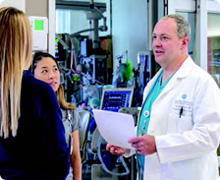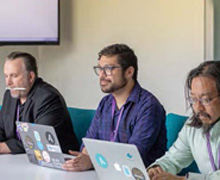Big Data, Better Results
We’re developing unique ways to protect kids from secondary health challenges associated with a stay in the ICU

The monitor behind Dr. Mark Wainwright displays a variety of real-time data streams generated during a child’s stay in an intensive care unit. Wainwright is leading the charge at Seattle Children’s to integrate these data streams and employ the power of big data analytics to recognize previously unnoticed patterns that indicate a child may be at risk of a secondary health issue.
As if it’s not stressful enough having a child in critical care, there’s an unsettling reality that parents and providers confront on a daily basis: Every kid treated in an intensive care unit (ICU) has an increased risk of neurological challenges down the line.
These secondary health challenges can affect their brain, their body and their emotions, and can drastically influence their quality of life months or even years after admission to an ICU.
But why does this happen? And what can be done to prevent it?
Dr. Mark Wainwright is leading the charge at Seattle Children’s to employ advanced data analytics to identify patterns in the data collected on critically ill children, including vital signs (such as respiration, heart rate, body temperature), organ function and laboratory data that indicate a child is at risk of developing a secondary injury to their brain or another organ. His team is creating a new type of monitoring that will give doctors and nurses a chance to intervene in real time before the injury occurs and to prevent long-term complications of critical illness.
“We’re good at saving children in pediatric ICUs. Only 2% to 4% of children die during or after an admission,” says Wainwright, a neurologist and co-director of our Neurosciences Center. “But we want more than survival for these kids. We want them to thrive.”
Powered by big data

Critical care physician Dr. Lincoln Smith, consulting with registered nurses Emily Kay and Haayoung Hwangpo on the pediatric intensive care unit, joined the big data project to improve clinicians’ ability to predict patient outcomes and to establish beneficial treatment plans.
Wainwright has pulled together a team of clinical providers, computer engineers and data analysts to work on developing systems that can uncover previously unrecognized patterns within existing data to predict future outcomes and trends.
“We know so much about our patients and we get mountains of information from the monitoring in the ICU. But we need to integrate it so we can see the information in new ways and make better clinical decisions,” says Dr. Lincoln Smith, a critical care physician at Seattle Children’s who is on the big data team.
It’s no small feat. The data comes from a variety of sources, including ICU monitors, a patient’s lab data, and even their medical history and genetic data. But this source data exists in different formats that were not designed to talk to each other.
The team is currently clearing the engineering hurdle of collecting, storing and integrating these complex data streams. They are also working on how to analyze the integrated data to identify patterns that can warn when a patient is at risk for a certain type of organ injury and suggest an appropriate treatment plan.
A key next step will be to track enough patients to establish the patterns that indicate when a patient is at risk and the treatments that have worked well for patients who experienced similar risks. Depending on the type of injury, this may take months to more than a year.
Precision medicine

Developing a system that can uncover previously unrecognized patterns within existing data streams requires the talents of folks whose specialized expertise is typically outside the healthcare setting, including (from left) data engineers Bryan Nice, Mike Sahari and Shu-Wai Chow.
While the project is still in its infancy, Wainwright and the team foresee a system that uses data – generated from ICU monitors and other sources – to create a unique model for a patient within the first couple of hours they are in the ICU. The system would then analyze the model and identify outcomes and complications that similar patients experienced in the past, as well as the therapies to which they responded well.
The system would continuously monitor the patient’s state, update the model and provide real-time information to the clinical team. The ability to predict how a child will do and to recommend treatments based on past patients is what truly differentiates this system from other integrated patient data streams operating around the country.
“This is a next step in offering personalized medicine to people being treated in the ICU,” notes Wainwright. “A system like this will enable us to deliver the right care, at the right time, in a way that is specific to how a child’s disease is evolving for them. With philanthropic support we can innovate more quickly and lead improvements in care for kids in the ICU.”
Connection, Winter 2019